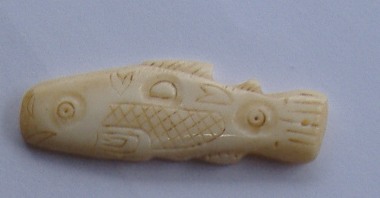Now available: ten-page printed guide to fake fetishes or shamans charms. includes: high quality photos of some of the fakes a list of bead-dealers who import these items eBay sources for bulk purchase in lots of 20-100 It is easy to tell whether the bone fetishes one sees are fakes; basically, all the figural bone or ivory fetishes commonly seen in live auctions, in antique shops and on eBay are fakes. These are fantasy items, originally produced for the bead trade; there are no genuine native items at all that look anything like these. Any item that looks like those pictured is a fake. This small brochure explains how to recognize these common fakes by their incongruous style, and too-perfect condition; the incised lines which are obviously made with modern motorized tools. More importantly, learn how to use logic to understand that items which appear in hundreds of copies cannot possibly be genuine Native American, Indian, Inuit, or Eskimo artifacts. If the same item appears in multiple copies, it is a forgery, even if someone has written a date or location on it. The carving of these items is now a cottage industry in Indonesia, with an annual production estimated in the tens of thousands of items. In 2005, the US Fish and Wildlife Service broke up an import/export crime ring; the crooks had been illegally obtaining marine ivory in the US, shipping it to Indonesia to be carved, and then importing it back into the US for sale. The confiscated inventory also included 10,000 otherwise-legal carvings made of Indonesian bone. These 10,000 pendants, whales, lances, otters, and so on, were auctioned off in September 2005. It is probably not a coincidence that large numbers of small carvings began to appear on eBay at about that time, sold by a whole rainbow of sellers. Applying a bit more logic, those 10,000 items were probably not a stockpile of several years work; but likely represented just a few months production. Even assuming that the Indonesian industry is producing only 10,000 carvings a year, that is a huge number compared to the few real Native items available through excavation or purchase from old collections. These are the items one finds advertised as old Native or Eskimo artifacts. They have no known use or purpose; they were developed by the Indonesian carving industry to sell to gullible Americans. There is no known use or historical precedent for these small decorative carvings. Needless to say, collections of 100-year old items cannot possibly contain exact duplicates of common, modern Indonesian forgeries; and of course the supposed "old" native items repeat the stylistic incongruities of the modern fakes. Note that recent examples are not even drilled with holes for hanging; in the listings for the bead trade, one is told that a hole may easily be drilled; but when these are illegally listed as old native items, how does one explain a supposed old native item that would be impossible to actually attach to anything? There are sellers who make a habit of selling these fakes, in a highly illegal way, by writing fake inscriptions on the back. One has sold 14 of them over the last two months. The inscriptions had dates from 1894 to 1925; they were "collected" from widely separated places, even though identical in design. This would clearly be impossible if the items were genuine. They included all the favorite imports: the whales, fish, bears, totems. It is hard to imagine that these sellers harbor any delusion that these items are genuine. They themselves have sold dozens of exact duplicates; and even a neophyte knows that real items do not appear in duplicates. The normal marketing of these fake items is to find them 1) in frames of 12-50, with a bone label stating Eskimo artifacts, and a location or 2) in similar frames with a copy of a newspaper article dealing with genuine artifacts and 3) sold individually, with a date and location written on the back in black. Such a notation on the back of a known fake is proof that there has been a criminal violation of the Federal law dealing with such items. The Indian Arts and Crafts Act prohibits the sale of fake Native items, and the brochure offered for purchase here will explain some of the options (such as demanding a refund, or making a report to the Indian Arts and Crafts Board) which are available to those who have bought such fake items. Here's what satisfied buyers said about this brochure: "As advertised! Good communication/transaction!! Thanks!!!" "Excellent transaction, item as described, prompt shipping." "Very Informative!" |










